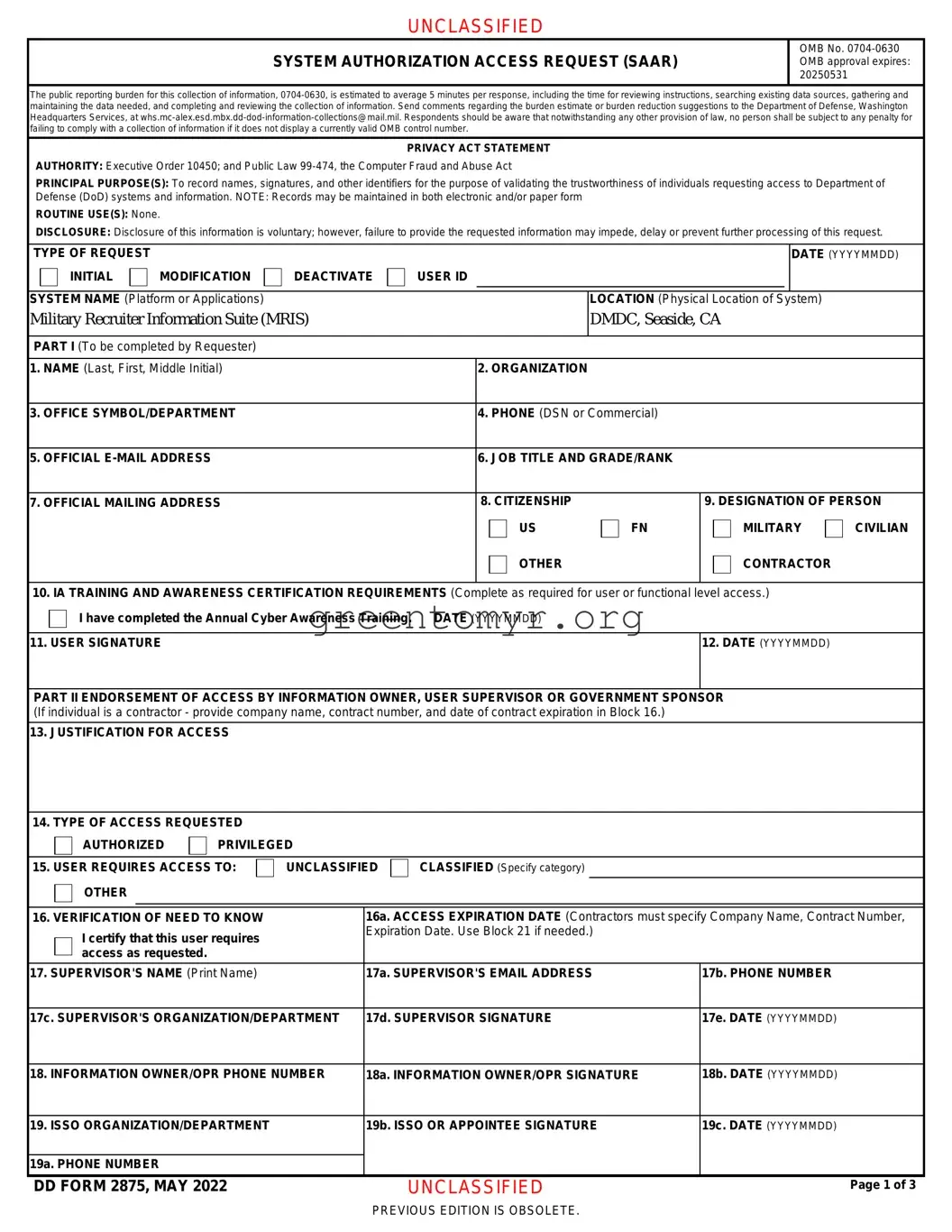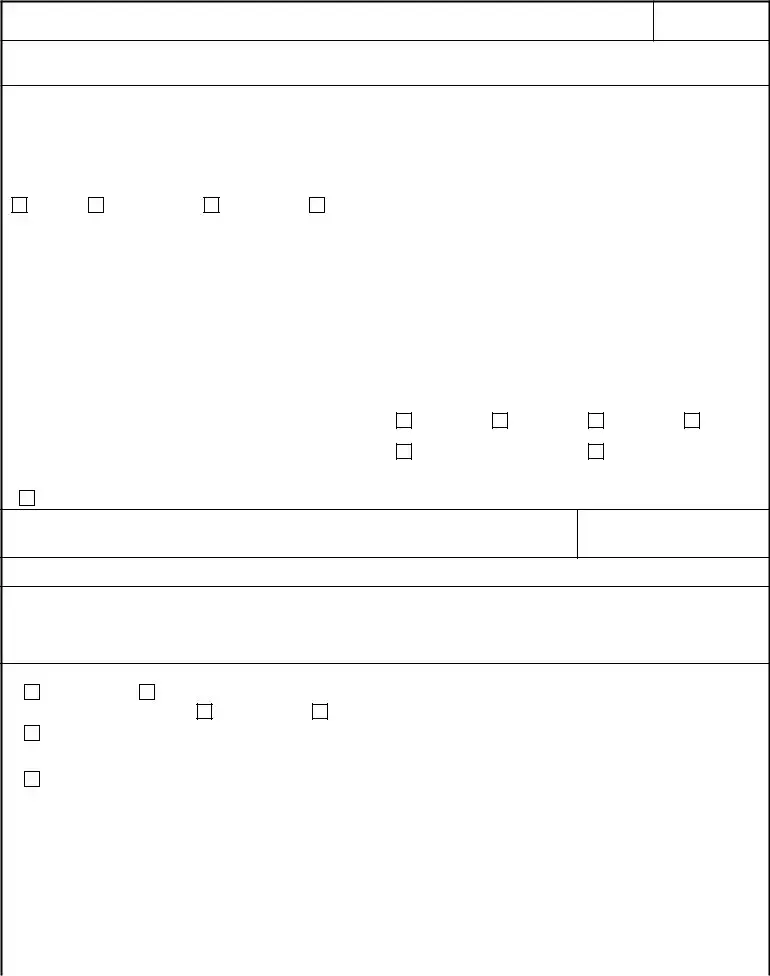A. PART I: The following information is provided by the user when establishing or modifying their USER ID.
(1)Name. The last name, first name, and middle initial of the user.
(2)Organization. The user's current organization (i.e. DISA, SDI, DoD and government agency or commercial firm).
(3)Office Symbol/Department. The office symbol within the current organization (i.e. SDI).
(4)Telephone Number/DSN. The Defense Switching Network (DSN) phone number of the user. If DSN is unavailable, indicate commercial number.
(5)Official E-mail Address. The user's official e-mail address.
(6)Job Title/Grade/Rank. The civilian job title (Example: Systems Analyst, GS-14, Pay Clerk, GS-5)/military rank (COL, United States Army, CMSgt, USAF) or "CONT" if user is a contractor.
(7)Official Mailing Address. The user's official mailing address.
(8)Citizenship (US, Foreign National, or Other).
(9)Designation of Person (Military, Civilian, Contractor).
(10)IA Training and Awareness Certification Requirements. User must indicate if he/she has completed the Annual Cyber Awareness Training and the date.
(11)User's Signature. User must sign the DD Form 2875 with the understanding that they are responsible and accountable for their password and access to the system(s).
(12)Date. The date that the user signs the form.
B. PART II: The information below requires the endorsement from the user's Supervisor or the Government Sponsor.
(13)Justification for Access. A brief statement is required to justify establishment of an initial USER ID. Provide appropriate information if the USER ID or access to the current USER ID is modified.
(14)Type of Access Required: Place an "X" in the appropriate box. (Authorized - Individual with normal access. Privileged - Those with privilege to amend or change system configuration, parameters, or settings.)
(15)User Requires Access To: Place an "X" in the appropriate box. Specify category.
(16)Verification of Need to Know. To verify that the user requires access as requested.
(16a) Expiration Date for Access. The user must specify expiration date if less than 1 year.
(17)Supervisor's Name (Print Name). The supervisor or representative prints his/her name to indicate that the above information has been verified and that access is required.
(17a) E-mail Address. Supervisor's e-mail address.
(17b) Phone Number. Supervisor's telephone number.
(17c) Supervisor's Organization/Department. Supervisor's organization and department.
(17d) Supervisor's Signature. Supervisor's signature is required by the endorser or his/her representative.
(17e) Date. Date the supervisor signs the form.
(18)Phone Number. Functional appointee telephone number.
(18a) Signature of Information Owner/Office of Primary Responsibility (OPR). Signature of the Information Owner or functional appointee of the office responsible for approving access to the system being requested.
(18b) Date. The date the functional appointee signs the DD Form 2875.
(19)Organization/Department. ISSO’s organization and department. (19a) Phone Number. ISSO’s telephone number.
(19b) Signature of Information Systems Security Officer (ISSO) or Appointee. Signature of the ISSO or Appointee of the office responsible for approving access to the system being requested.
(19c) Date. The date the ISSO or Appointee signs the DD Form 2875.
(21)Optional Information. This item is intended to add additional information, as required.
C. PART III: Verification of Background or Clearance.
(22)Type of Investigation. The user's last type of background investigation (i.e., Tier 3, Tier 5, etc.).
(22a) Investigation Date. Date of last investigation.
(22b) Continuous Evaluation (CE) Deferred Investigation. Select yes/no to validate whether or not the user is currently enrolled for “Deferred Investigation” in the Continuous Evaluation (CE) program.
(22c) Continuous Evaluation Enrollment Date. Date of CE enrollment. Leave blank if user is not enrolled in CE.
(22d) Access Level. The access level granted to the user by the sponsoring agency/service (i.e. Secret, Top Secret, etc.). Access level refers to the access determination made on the basis of the user’s individual need for access to classified information to perform official duties; a determination separate from the user’s eligibility determination.
(23)Verified By. The Security Manager or representative prints his/her name to indicate that the above clearance and investigation information has been verified.
(24)Phone Number. Security Manager’s telephone number.
(25)Security Manager Signature. The Security Manager or his/her representative indicates that the above clearance and investigation information has been verified.
(26)Verification Date. Date the Security Manager performed the background investigation and clearance information verification.
D. PART IV: This information is site specific and can be customized by either the DoD, functional activity, or the customer with approval of the DoD. This information will specifically identify the access required by the user.
E. DISPOSITION OF FORM:
TRANSMISSION: Form may be electronically transmitted, faxed, or mailed. Adding a password to this form makes it a minimum of e CONTROLLED UNCLASSIFIED INFORMATION” and must be protected as such.
FILING: Original SAAR, with original signatures in Parts I, II, and III, must be maintained on file for one year after termination of user's account. File may be maintained by the DoD or by the Customer’s ISSO. Recommend file be maintained by ISSO adding the user to the system.



